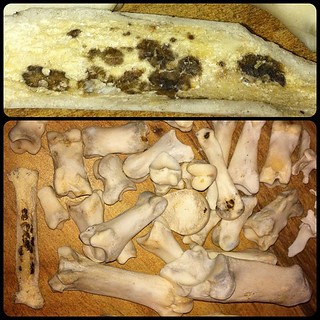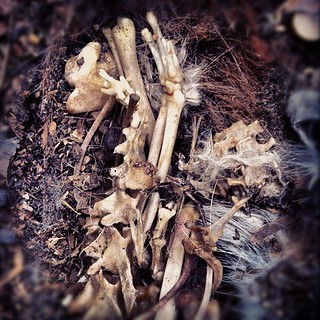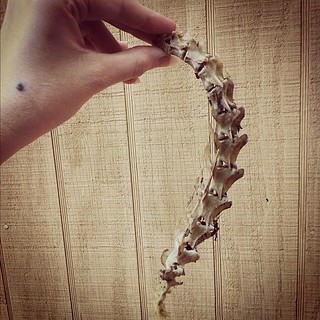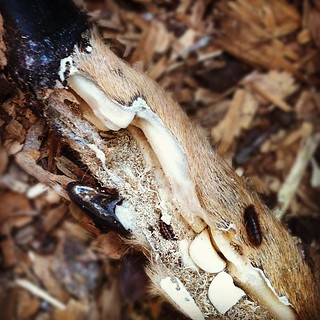
I recently edited my
Bad Words: BOIL & BLEACH post here adding much more extensive info about using hydrogen peroxide (H2O2). Posting it as a new blog with even more info and photos so you guys don't miss this important info.

In the H2O2 bath.

Drying after the H2O2 bath.
NEVER use chlorine bleach on bones.
Chlorine based bleach permanently damages the bone itself. It will start
to break down the structure of the bone and will continue to even after
it is rinsed and dried. Resulting in chalky, fragile and extremely
porous bone that will turn to bone meal with age. Not to mention it
turns the bone yellow. Which pretty much defeats the purpose if you are
trying to whiten the bone. It may appear white at first but will turn yellow. Once it yellows from bleach there is nothing
you can do about it. Believe me, I've tried to salvage yellow bleached
skulls before to no avail.

To sanitize and whiten bone use regular household hydrogen peroxide
(H2O2) that you can easily and inexpensively get ahold of at the grocery
store, dollar store or drugstore. Do a 50/50 bath with water just above
the bones in a loose lidded plastic container to reduce evaporation.
Oxygen activates the peroxide so you want to let air get to it. But it
will evaporate so keep an eye on it and top it off as needed. Also, if
you have a tight lid on it pressure may build up and the top literally
blows off.

Lids are loose to let oxygen in and pressure out.
How long? Just keep the bones in this bath until they are the
color you want them. This is a personal preference. Note that the bone
will dry lighter than it looks wet. This process can take days or weeks.
Although if you leave it too long it will eventually make the bone
brittle. But this usually would take months for medium sized bones like
say of a raccoon. This is a very safe process for most bones if you
properly follow my steps. When done whitening, rinse the bones in water
then lay out to dry in the sun on towels or dry inside with a fan on. I
put towels or paper towels under the bones to help pull moisture out. Be
sure the bones are dry before you put them in a sealed container for
storage or they may mold.

Sun drying bones.
More About Mold
These were bright white cleaned bones. I thought I had left them out to dry long enough but apparently hadn't. I bagged them up in a ziploc and put them in my supply drawer. Only to find some time later that the had become splotched with black mold through the bone core and on the outside. I soaked them for weeks in full strength hydrogen peroxide but they only got this white again. In the closeup on top you can see the actual mold inside the bone. I think the molding also had to do with the bone needing to be degreased more. The mold spread to all bones in the batch though. Those not needing degreasing as well.

These bones had been cleaned and dried but got humid and grew a green fuzzy mold on them. Luckily I just hosed them off and gave them a H2O2 bath and they cleaned up beautifully. So this is a reminder to store bones in a dry place.
 Important factors:
Important factors: If your H2O2 bath gets really cloudy you
likely need to dump it out and start a new bath. Otherwise it will start
to macerate instead. Do not use a metal container with H2O2. Use
plastic or glass. Store in a
cool dark place. Direct sunlight will eventually deactivate H2O2 that's
why it comes in dark containers. Do not do this step outside with no
lid. You will just end up with deactivated H2O2, algae and insect larvae
all over you bones and you'll have to start over... or the bones may be
ruined.

Bubbles is a good sign your H2O2 is still active.
DO NOT use hair developer type peroxide on bones, ever.
There are
additional ingredients in it besides H2O2 and it is MUCH stronger than
regular corner store purchased H2O2. Which I think is only 3%. I have experimented with this
myself and the developer turned huge deer vertebrae to literally mush in
my hands. Likewise, do not use the powdered hair bleach packets. The
same results will happen. So you've been warned!

Improperly processed vertebrae that turned to mush in my hands.
Algae & Moss Covered Nature Cleaned Bones
Note that some staining will not come out especially if bones were
decaying on the forest floor for some time. Remember, you want to be
sure the bones have already been degreased and cleaned of all
flesh/dirt/etc before putting into the peroxide.

Too late to clean and whiten these bones. After bones have been left in
the elements for some time they begin to break down. These bones are now
"living" again covered with algae/fungi that is eating it. This is one
reason I choose not to do the bury method. If you wait too long bones
have already begun to decay. I like processing methods where I can see
what is happening to the remains at all times.
 BONE PROCESSING BLOG POST WITH TIMELINE:
BONE PROCESSING BLOG POST WITH TIMELINE:

See the post that goes along with the above photo here -
BONELUST BONE PROCESSING PROGRESS: First Adult Goat Skull processing progression photos & timeline.
For even more extensive info about all the steps I use in processing bones check out the rest of my blog. Enjoy!









































